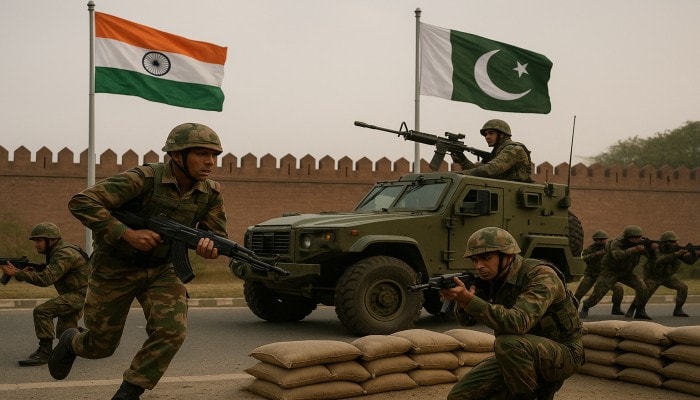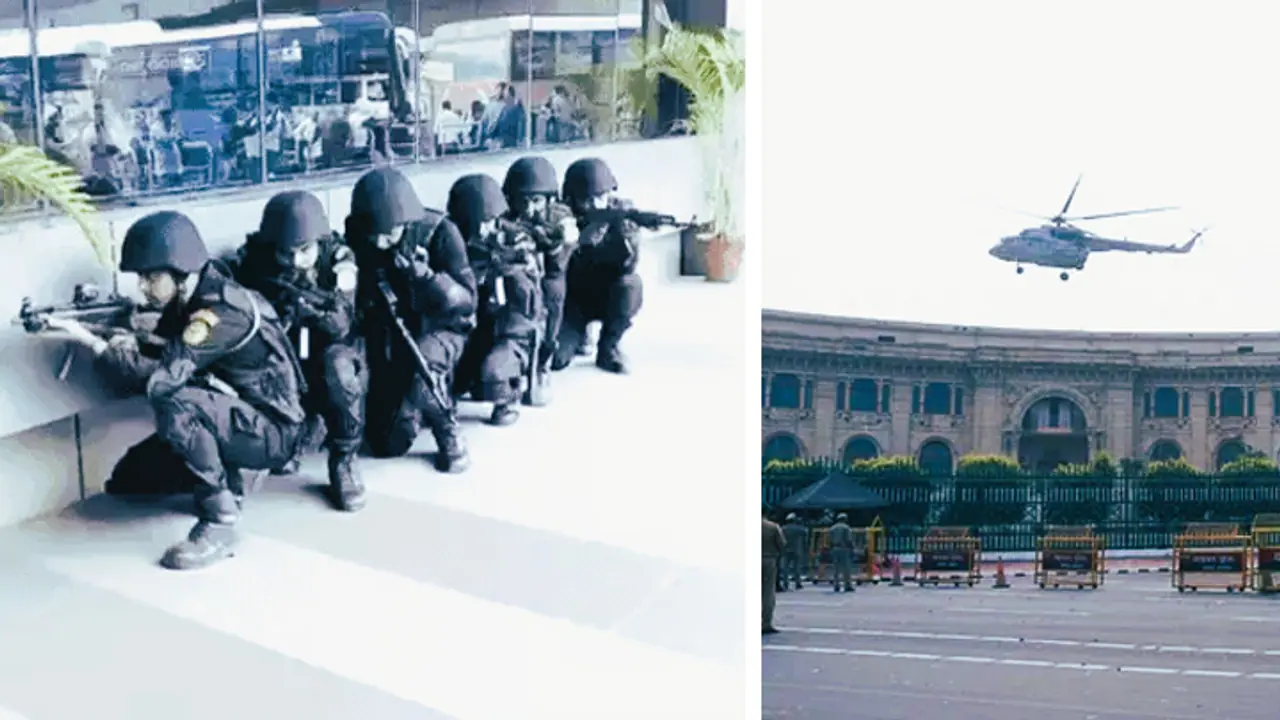The Centre has announced a nationwide civil defence drill on May 7 across 259 locations.
Amid heightened and rising tensions between two nuclear-armed neighbouring countries, India will conduct a series of mock drills across 259 locations on May 7. Coming just days after a dastardly terror attack in Pahalgam and in the wake of Pakistan’s recent missile tests under “Exercise INDUS,” the mock drills are a clear indication to reinforce internal readiness for worst-case scenarios, including airstrikes or full-scale warfare.
An official in the Union home ministry cited the reasons for conducting the mock drills across the country, including to train civilians, students, and others in civil defence techniques for protection during a hostile attack. The county will also check the readiness of control rooms and shadow control centres.
Sources in the ministry of home affairs said that the mock drills will be conducted in 244 categorised civil defence districts on Wednesday. “Such civil defence drills keep taking place in districts on a regular basis. But this time we are conducting across the country,” an official said.
The decision to hold mock drills for effective civil defence has been taken in the wake of the Pahalgam terror attack on April 22 that killed 26 Indian tourists in Jammu and Kashmir.

Full list of locations where mock drill will take place
States/UT: Andaman and Nicobar Island
Category 1: NA
Category 2: Port Blair
Category 3: NA
States/UT: Andhra Pradesh
Category 1: NA
Category 2: Hyderabad, Vishakhapatnam
Category 3: NA
States/UT: Arunachal Pradesh
Category 1: NA
Category 2: Alog (west Siang), Itanagar, Tawang, Hayuling
Category 3: Bomdila
States/UT: Assam
Category 1: NA
Category 2: Bongaigaon, Dibrugarh, Dhubri, Goalpara, Jorhat, Sibsagar, Tinsukia, Tezpur, Digboi, Diliajan, Guwahati (Dispur), Rangia, Namrup, Nazira, North Laskshimpur, Numaligarh
Category 3: Darrang, Golaghat, Karbi-anglong, Kokrajhar
States/UT: Bihar
Category 1: NA
Category 2: Barauni, Katihar, Patna, Purnea
Category 3: Begusarai
States/UT: Chandigarh
Category 1: NA
Category 2: Chandigarh
Category 3: NA
States/UT: Chhattisgarh
Category 1: NA
Category 2: Durg (Bhilai)
Category 3: NA
States/UT: Dadar Nagar Haveli
Category 1: NA
Category 2: Dadar (Silvasa)
Category 3: NA
States/UT: Daman and Diu
Category 1: NA
Category 2: Daman
Category 3: NA
States/UT: Delhi
Category 1: Delhi (including new Delhi and Delhi cantonment)
Category 2: NA
Category 3: NA
States/UT: Goa
Category 1: NA
Category 2: North goa (Panaji), South Goa (Marmagoa with Vasco Dabolim and Harbour)
Category 3: NA
States/UT: Gujarat
Category 1: Surat, Vadodara, Kakrapar
Category 2: Ahmedabad, Jamnagar, Gandhinagar, Bhavnagar, Kandla, Nalia, Ankeleswar, Okha, Vadinar
Category 3: Bharuch, Dangs, Kutch, Mehsana, Narmada, Navsari
States/UT: Haryana
Category 1: NA
Category 2: Ambala, Faridabad, Gurgaon, Hissar, Panchkula, Panipat, Rohtak, Sirsa, Sonepat, Yamuna Nagar
Category 3: Jhajjar
States/UT: Himachal Pradesh
Category 1: NA
Category 2: Shimla
Category 3: NA
States/UT: Jammu and Kashmir
Category 1: NA
Category 2: Anantnag, Badgam, Baramula, Doda, Jammu, Kargil, Kathua, Kupwara, Leh, Poonch, Rajauri, Srinagar, Udhampur, Samba, Akhnoor, Uri, Naushera, Sunderbani, Awantipur
Category 3: Pulwama
States/UT: Jharkhand
Category 1: NA
Category 2: Bokaro, Gomio, Jamshedpur, Ranchi
Category 3: Godda, Sahebganj
States/UT: Karnataka
Category 1: NA
Category 2: Bengaluru (urban), Malleshwar, Raichur
Category 3: NA
States/UT: Kerala
Category 1: NA
Category 2: Cochin( Kochi), Tiruvananthapuram
Category 3: NA
States/UT: Lakshadweep
Category 1: NA
Category 2: Lakshadweep (Kavarati)
Category 3: NA
States/UT: Madhya Pradesh
Category 1: NA
Category 2: Bhopal, Gwalior, Indore, Jabalpur, Katni
Category 3: NA
States/UT: Maharashtra
Category 1: Mumbai, Uran, Tarapur
Category 2: Thane, Pune, Nasik, Rohan-Dhato- Nagothane, Monmad, Sinner, Thal Vayshot, Pimpri Chinchwad
Category 3: Aurangabad, Bhusawal, Raigarh, Ratnagiri, Sindudurg
States/UT: Manipur
Category 1: NA
Category 2: Imphal, churachandpur, ukhrul, Moreh, Ningthou-Khong
Category 3: NA
States/UT: Meghalaya
Category 1: NA
Category 2: East Khasi hill (Shillong), Jaintia hill (jawai), west Garo hill (Tura)
Category 3: NA
States/UT: Mizoram
Category 1: NA
Category 2: Aizawal
Category 3: NA
States/UT: Nagaland
Category 1: NA
Category 2: Dimapur, Kohima, Mokokchung, Mon, Phek, Tuensang, wokha , Zunheboto , Kephir, Perren
Category 3: NA
States/UT: Odisha
Category 1: Talcher
Category 2: Balasore, Koraput, Bhubaneswar, Gopalpur, Hirakund, Paradip, Rourkela
Category 3: Bhadrak, Dhenkanal, Jagatsinghpur, Kendrapara
States/UT: Puducherry
Category 1: NA
Category 2: Puducherry
Category 3: NA
States/UT: Punjab
Category 1: NA
Category 2: Amritsar, Bhatinda, Ferozepur, Gurdaspur, Hoshiarpur, Jalandhar, Ludhiana, Patiala, Pathankot, Adhampur, Barnala, Bhakra- Nangal, Halwara, Kothkapur, Batala, Mohali (Sasnagar), Abohar
Category 3: Faridpur, Ropar, Sangrur
States/UT: Rajasthan
Category 1: Kota, Rawat-Bhata,
Category 2: Ajmer, Alwar, Barmer, Bharatpur, Bikaner, Bundi, Ganganagar, Hanumangarh, Jaipur, Jaisalmer, Jodhpur, Udaipur, Sikar, Nal, Suratgarh, Abu Road, Nasirabad (Ajmer), Bhivari
Category 3: Phulera( Jaipur), Nagaur (Merta Road), Jalore, Bewar (Ajmer), Lalgarh (Ganaganagar), swai Madhopur, Bhilwara, Pali
States/UT: Sikkim
Category 1: NA
Category 2: Gangtok
Category 3: NA
States/UT: Tamil Nadu
Category 1: Chennai, Kalpakkam
Category 2: NA
Category 3: NA
States/UT: Tripura
Category 1: NA
Category 2: Agartala
Category 3: NA
States/UT: Uttar Pradesh
Category 1: Bulandshehar (Narora)
Category 2: Agra, Allahabad, Bareilly, Ghaziabad, Gorakhpur, Jhansi, Kanpur, Lucknow, Mathura, Meerut, Moradabad, Sharanpur, Varanasi, Bakshi-ka-Talab Mughalsarai, Sarsawa,
Category 3: Bagpat, Muzzafar Nagar
States/UT: Uttarakhand
Category 1: NA
Category 2: Dehradun
Category 3: NA
States/UT: West Bengal
Category 1: NA
Category 2: Coochbehar, Darjeeling, Jalpaniguri, Mala, Siliguri, Greater Kolkata, Durgapur, Haldia, Hashimara, Kharagpur, Burnpur- Asansol, Farakka-Khejuriaghat, Chittaranjan, Balurghat, Ali purwar, Raiganj, Islampur, Dinhata, Makhili ganj, Mathabhanga, Kalimpong, jaldhaka, Kurseong, Kolaghat,
Category 3: Bardhaman, Birbhum, East Midnapur, West Madinapur, Hawrah, Hooghly, Murshidabad
Notably, states such as Delhi, West Bengal, and Punjab have a strong presence of active civil defence volunteers regularly engaged in civic duties, including traffic and crowd management. India's civil defence system operates primarily on a voluntary basis, supported by a small core of paid personnel, and is scaled up during emergencies.
Keep cash, torch, medical kits handy: How to be prepared
According to a Home Ministry statement, the drills will focus on how to respond to air raid sirens and blackout situations. Sources said citizens will be instructed to keep medical kits with extra supplies, torches, and candles at home.
As per sources, people will be advised to keep cash handy to navigate situations where mobile devices and digital transactions may fail.
A review meeting held in the Ministry of Home Affairs on Tuesday assessed the condition of civil defence installations across 244 districts such as shelters, warning systems, and coordination facilities—are in working condition or require repairs.
Training for civilians will be a key component of the drills.
Why does this matter?
Amid rapid evolving geopolitical tensions between two nations, India has been emphasising the need for “optimum Civil Defence preparedness.”
The notification explicitly references the evolving nature of national security risks, stating that states must remain ready to handle emergencies like air raids, internal disruptions, or full-scale attacks.
An official said that this is the most expansive civilian defence mobilisation effort since the Cold War era, signaling a shift in India’s internal security posture.
What will the drill involve?
The mock drill will unfold across multiple levels, from districts to village clusters, and will simulate scenarios like air strikes, mass evacuations, and communication blackouts. Local administrations are expected to conduct these drills with public and institutional participation.
Key participants will include Civil Defence wardens, Home Guard volunteers (active and reservists), members of the NCC, NSS, NYKS, and students from schools and colleges.
Key measures to be tested
Air Raid Siren Activation: Designated towns will test their air raid warning systems to alert civilians in case of an aerial attack. This is aimed at ensuring that alert infrastructure is functional and can trigger swift public sheltering.
Civilian Training: Workshops and drills in schools and public institutions will focus on how civilians can react during a hostile event, covering everything from basic first aid to emergency evacuation steps.
Blackout Protocols: Cities and installations will undergo blackout exercises to test their ability to "go dark" in minutes. This includes turning off all lights and electronic signals to avoid detection by enemy reconnaissance.
Camouflage Exercises: Strategic installations, such as power stations, defence infrastructure, and communication hubs, will be camouflaged to assess how quickly and effectively such assets can be concealed from enemy targeting.
Evacuation Drills: Dry runs of evacuation plans will be held to identify flaws in existing procedures and to ensure smooth movement of people from high-risk zones to safer areas.
Key Implications:
Public Awareness: The involvement of educational institutions and public agencies helps normalize preparedness as a civic responsibility.
Inter-Agency Coordination: The drills will reveal how well local and central authorities can communicate and act in concert during emergencies.
Strategic Messaging: Holding such a large-scale drill just after a high-casualty terror attack and missile tests sends a calculated message to both domestic and foreign audience.


